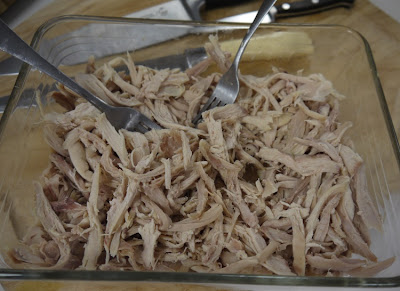Quality is one of the most important things to understand in today's world of commercial factory farming. The above slide is from the classes I taught five years ago. Nothing has changed except the scope of commercial factory farming has increased, and the quality of the food produced has decreased.
On the right is a photo I took of some of our chickens in 2007. I think everyone would agree that there is a world of difference in the quality of the eggs produced by the chickens confined to cages and those free ranging on green grass and bugs. (In addition, I also make my own soy-free chicken feed which includes sprouted organic grains.) We can see and taste the difference in the eggs.
Unfortunately, when we shop at the grocery store, we are completely out of touch with how the food was produced. It is easy to read labels and see what is not a good choice, but what about foods like eggs, meats, fish, produce, etc. How a food is grown or raised is also very important. That is why I frequently say to buy the best you can afford. Find the local farmers and ranchers; we have many in the DFW area. Support these people who are producing better quality foods.
This is what I wrote five years ago, it is still true:
I cannot stress enough that the factor which determines if a food is nourishing is its quality. How was it grown, raised and processed? Eggs can be healthy or unhealthy. Yogurt can be healthy or unhealthy. Salmon can be healthy or unhealthy. This is true for just about all of the foods we eat. The meat in most stores has been raised at a commercial factory farm. The animals are fed cheap feeds and by-products, not their natural diet. They are living in very close, unsanitary, cramped spaces. They are genetically modified or given hormones to grow faster or increase their production, and they are given a low dose of antibiotics to keep these sick creatures alive until they can be processed. Factory farm products do not provide healing nutrients.
Yogurt contains the natural bacteria needed for a healthy gut. However, many yogurts contain additives, are loaded with refined sugar, and contain very little of the good bacterias. So blanket statements such as “yogurt is good for you, or beef is bad for you” are inaccurate.
It is very important to learn where your food comes from and how it has been processed. This can be a huge task, so I hope to help guide you through the initial, basic points.
God’s nourishing food supply has been around for centuries. Try to eat foods as supplied in nature or those with minimal processing. Use the ‘old’ ways of cooking and preparing foods starting with fresh ingredients from scratch. I will teach you the basics of cooking and baking. From there, you can choose to cook very simple meals, or you can create delicious gourmet meals. As long as you use God’s foods, either works to gain and maintain health.
Lots of great foods are available to us, but these foods are not found at the typical local grocery store. Be careful of misinformation that you might receive from the grocery store. After Tuesday's class, someone asked Kroger if they had organic chickens. The response was, that "he had 100% natural and the only difference is that an organic chicken is let out of the cage for the last 30 days of its life. He said that they are fed the same food." I disagree that the two are fed the same feed, but even if they were, think about this. Chickens have been bred to live in low-light conditions and to fatten up VERY quickly. Instead of taking months to grow to full size, it now takes weeks. Typical age when butchered is 5 to 7 weeks. Chicks, commercial and free range, are kept in a brooder until they feather out for the first 7 to 10 days of life. So this would mean from Kroger's answer about the chickens, that the 100% natural chicken lives it's entire life in a cage. Actually, they are not kept in individual cages as the egg layers, which are shown above. Broilers wings are clipped and they are all kept together in large rooms, such as this.






.JPG)















.jpg)

















